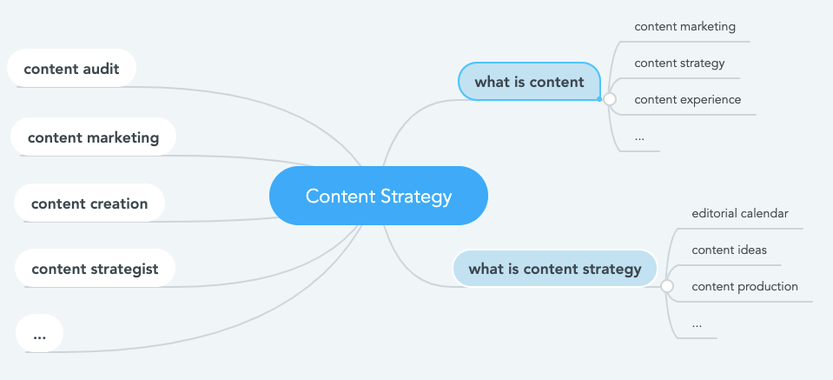This document covers important fundamental concepts that will make it easier to edit Content Briefs. Creating a Content Brief is a three-step process, starting with Step 1 Ordering a Content Brief.
The Basic Topic Model
A simple topic model consists of a focus topic and its related topics. You’ve seen this type of model if you’ve used the Research or Optimize Applications. Content Score is based on the usage of those specific related topics.
Imagine we’re using Optimize to create a piece of content. Let say our focus topic, the subject of our article, is “content strategy.” Here’s a sampling of related topics we’ll use to reach the Target Content Score.

We can add sections like “what is content?” and “what is content strategy?” to the article. But the related topics we include are based on the focus topic “content strategy.” That will be how we determine if we achieve the Target Score.
The Advanced Topic Model
Let’s make this article even better by ensuring we address important topics related specifically to the different sections. We do this by creating a topic model for each section in our article.
So the section “What is Content?” will have its own topic model using the focus topic “what is content.” The section “What is Content Strategy?” will also have its own topic model using the focus topic “what is content strategy.”
Here’s a comparison of a simple topic model (like that used in Optimize) and an advanced topic model (like that in a Content Brief).

To keep organized let’s refer to related topics belonging to the focus topic “content strategy” as root topics. They’re the topics we’re going to use to ensure we stay on-point and achieve our Target Content Score.
The other topics will be worked into the narrative of their respective sections. In that way we’ll have a comprehensive article about “content strategy” combined with balanced coverage of the subsections’ topics.
Achieving that score ensures that any subsection doesn’t take prominence over the main subject of the content. In this case we want to focus the article on “content strategy” and not “what is content” or “what is content strategy.”
Subsection Topics and Root Topics
There should be a degree of overlap between a subsection’s topics and that of the article’s subject (the root topics). This makes sense. Looking at the example above, one would expect the subsections “what is content” and “what is content strategy” to have something in common with the main topic, “content strategy.” That’s why they’re being included, as opposed to a section about “best times to post to LinkedIn.”
While there’s no hard and fast rule, there should be enough common ground to establish a relationship between subheading and main article. However, that should not extend to the point where the topic model of a subsection practically duplicates that of the main topic.
Flagged Topics
In a Content Brief, MarketMuse flags topics associated with the main subject of the article. It’s important to have a sufficient number of these in order to achieve the Target Content Score. The Content Brief indicates how many you have (are visible) and how may are required.
Usually, there is some overlap in related topics between sections and root topics of the main subject. In the example above, “content marketing” is a root topic and a related topic in the section “what is content.” In other words, it appears in topic models for “content strategy” and “what is content.”
